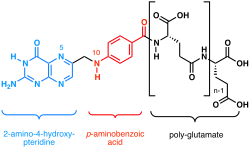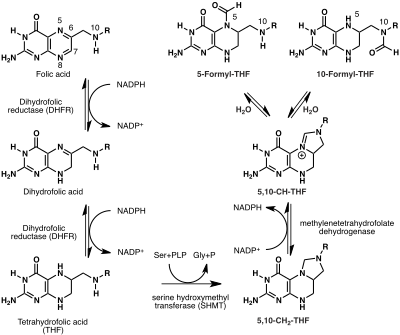Folate/ja: Difference between revisions
Created page with "===安全性=== 葉酸は水溶性ビタミンであり、定期的に尿を通して体外に排出されるため、葉酸による毒性のリスクは低い。葉酸の大量摂取に関連する潜在的な問題のひとつは、ビタミンB<sub>12</sub>欠乏による悪性貧血の診断にマスキング効果をもたらすことであり、ビタミンB12欠乏患者では神経障害を誘発または悪化させる可能性さえ..." Tags: Mobile edit Mobile web edit |
|||
| Line 290: | Line 290: | ||
米国医学研究所は、推定平均必要量(EAR)、推奨食事許容量(RDA)、適正摂取量(AI)、耐容上限摂取量(UL)を定義しており、これらを総称して[[Dietary Reference Intake/ja|食事摂取基準]](DRI)と呼ぶ。[[:en:European Food Safety Authority|欧州食品安全機関]](EFSA)は、RDAの代わりに人口基準摂取量(PRI)、EARの代わりに平均必要量を用いて、これらの情報の集合体を食事摂取基準値(Dietary Reference Values)と呼んでいる。AIとULの定義は米国と同じである。歳以上の女性および男性のPRIは330 μg/日に設定されている。妊娠中のPRIは600 μg/日、授乳期は500 μg/日である。1~17歳の子どもについては、年齢とともにPRIは120~270 μg/日と増加する。これらの値は、米国のRDAとは多少異なる。1991年に食品・栄養政策の医学的側面に関する委員会(Committee on Medical Aspects of Food and Nutrition Policy)によって設定されたイギリスの葉酸の食事摂取基準値は、成人で200 μg/日である。 | 米国医学研究所は、推定平均必要量(EAR)、推奨食事許容量(RDA)、適正摂取量(AI)、耐容上限摂取量(UL)を定義しており、これらを総称して[[Dietary Reference Intake/ja|食事摂取基準]](DRI)と呼ぶ。[[:en:European Food Safety Authority|欧州食品安全機関]](EFSA)は、RDAの代わりに人口基準摂取量(PRI)、EARの代わりに平均必要量を用いて、これらの情報の集合体を食事摂取基準値(Dietary Reference Values)と呼んでいる。AIとULの定義は米国と同じである。歳以上の女性および男性のPRIは330 μg/日に設定されている。妊娠中のPRIは600 μg/日、授乳期は500 μg/日である。1~17歳の子どもについては、年齢とともにPRIは120~270 μg/日と増加する。これらの値は、米国のRDAとは多少異なる。1991年に食品・栄養政策の医学的側面に関する委員会(Committee on Medical Aspects of Food and Nutrition Policy)によって設定されたイギリスの葉酸の食事摂取基準値は、成人で200 μg/日である。 | ||
===安全性=== | |||
=== | 葉酸は水溶性ビタミンであり、定期的に尿を通して体外に排出されるため、葉酸による毒性のリスクは低い。葉酸の大量摂取に関連する潜在的な問題のひとつは、ビタミンB<sub>12</sub>欠乏による[[pernicious anaemia/ja|悪性貧血]]の診断にマスキング効果をもたらすことであり、ビタミンB12欠乏患者では神経障害を誘発または悪化させる可能性さえある。このエビデンスにより、葉酸のULを設定することが正当化された。一般に、ビタミンやミネラルのULは、十分なエビデンスがある場合に設定される。葉酸の成人用ULである1,000 μg(小児はそれ以下)は、サプリメントとして使用される葉酸に特化したものである。EFSAは、安全性の問題を検討し、ULを1,000 μgとすることに米国と合意した。日本の国立健康・栄養研究所は、成人のULを年齢に応じて1,300または1,400μgに設定した。 | ||
<div lang="en" dir="ltr" class="mw-content-ltr"> | <div lang="en" dir="ltr" class="mw-content-ltr"> | ||
Revision as of 15:25, 5 April 2024
 | |
 | |
| Clinical data | |
|---|---|
| Pronunciation | /ˈfoʊlɪk, ˈfɒlɪk/ |
| Trade names | Folicet, Folvite |
| Other names | Wills factor, FA, N-(4-{[(2-amino-4-oxo-1,4-dihydropteridin-6-yl)methyl]amino}benzoyl)-L-glutamic acid, pteroyl-L-glutamic acid, folacin, vitamin B9; formerly, vitamin Bc and vitamin M |
| AHFS/Drugs.com | Monograph |
| MedlinePlus | a682591 |
| License data |
|
| Pregnancy category |
|
| Routes of administration | 口から, 筋肉内, 静脈内, 皮下 |
| ATC code | |
| Legal status | |
| Legal status | |
| Pharmacokinetic data | |
| Bioavailability | 50–100% |
| Metabolism | Liver/ja |
| Excretion | Urine |
| Identifiers | |
| |
| CAS Number | |
| PubChem CID | |
| IUPHAR/BPS | |
| DrugBank |
|
| ChemSpider | |
| UNII |
|
| KEGG | |
| ChEBI | |
| ChEMBL | |
| PDB ligand | |
| Chemical and physical data | |
| Formula | C19H19N7O6 |
| Molar mass | 441.404 g·mol−1 |
| 3D model (JSmol) | |
| Density | 1.6±0.1 g/cm3 |
| Melting point | 250 °C (482 °F) (decomposition) |
| Solubility in water | 1.6mg/L (25 °C) |
| |
| |
葉酸は、ビタミンB9やフォラシンとも呼ばれ、ビタミンB群の1つである。体内で葉酸に変換される製造された葉酸は、加工時や保存時に安定性が高いため、栄養補助食品や食品強化に用いられる。葉酸は、体内でDNAとRNAを作り、細胞分裂に必要なアミノ酸を代謝するのに必要である。葉酸は人体で作ることができないため、食事から摂取する必要があり、必須栄養素である。多くの食品に自然に含まれている。米国における推奨される成人の1日の葉酸摂取量は、食品または栄養補助食品から400マイクログラムである。
葉酸の形態の葉酸は、葉酸欠乏症によって引き起こされる貧血の治療に用いられる。葉酸はまた、胎児の神経管欠損症(NTDs)のリスクを減らすために、妊娠中の女性がサプリメントとして使用する。妊娠初期の低レベルが、NTDを持つ赤ちゃんの半数以上の原因であると考えられている。80カ国以上が、NTDの発生率を低下させるための対策として、特定の食品に葉酸を義務的または自主的に強化している。比較的多量の葉酸を長期的に補給すると、脳卒中のリスクがわずかに低下し、前立腺がんのリスクが上昇する。大量の葉酸補給は、ビタミンB12欠乏症を隠してしまう懸念がある。
葉酸を十分に摂取しないと、葉酸欠乏症になることがある。その結果、赤血球が異常に大きくなる貧血の一種になることがある。症状としては、疲労感、動悸、息切れ、舌のただれ、皮膚や髪の色の変化などがある。小児の葉酸欠乏症は、食事からの摂取が不十分だと1ヵ月以内に発症することがある。
葉酸は1931年から1943年にかけて発見された。WHOの必須医薬品リストに掲載されている。> 2021年には、米国で77番目に多く処方された医薬品であり、8 万回以上の処方があった。葉酸」という言葉は、ラテン語のfolium(葉を意味する)に由来しており、深緑色の葉野菜に含まれていたためである。
定義

葉酸(ビタミンB9)は、テトラヒドロ葉酸(活性型)、メチルテトラヒドロ葉酸(血中に含まれる主要型)、メテニルテトラヒドロ葉酸、フォリン酸、フォラシン、プテロイルグルタミン酸などを含む、葉酸およびその関連化合物の多くの形態を指す。歴史的な名称には、L. casei因子、ビタミンBc、ビタミンMなどがある。
葉酸(folate)と葉酸(folic acid)という用語は、文脈によってやや異なる意味を持つが、互換的に用いられることもある。有機化学の分野では、葉酸(falate)は葉酸(folic acid)の共役塩基を指す。生化学の分野では、葉酸(folate)は葉酸(folic acid)に関連し、葉酸を含む生物学的に活性な化合物の一群を指す。栄養学の分野では、葉酸(folate)という用語は栄養補助食品として使用される製造された葉酸(folic acid)のために予約されているのに対し、葉酸(folic acid)は天然源から得られる葉酸に関連する必須栄養素のファミリーである。
化学的には、葉酸は3つの異なる化学部分が結合したものである。プテリン(2-アミノ-4-ヒドロキシ-プテリジン)複素環環は、p-アミノベンゾイル基とメチレン橋で結合しており、この基はアミド結合を介してグルタミン酸またはポリグルタミン酸のいずれかと結合している。プテリジン環のN5窒素原子および/またはp-アミノベンゾイル基のN10窒素原子には、様々な酸化状態の炭素1単位が結合していてもよい。
健康への影響
葉酸は、乳児期や妊娠中など、細胞分裂や成長が頻繁に起こる時期に特に重要である。葉酸欠乏はDNA合成と細胞分裂を妨げ、細胞分裂の頻度が高い造血細胞や新生物に最も影響を及ぼす。RNA転写とそれに続くタンパク質合成は、mRNAを再利用して再び使用することができるため、葉酸欠乏による影響は少ない(新しいゲノムコピーを作成しなければならないDNA合成とは対照的である)。
出生異常
妊婦の葉酸欠乏は神経管欠損症(NTDs)に関与しており、多くの国で食品強化が義務化される以前は、世界で30万件の症例があったと推定されている。そのため、妊娠を計画している女性は、妊娠前および妊娠中に葉酸を含む栄養補助食品を摂取することが推奨されている。米国疾病予防管理センター(CDC)は、NTDs予防のために1日400マイクログラムの葉酸を推奨している。この推奨の遵守は完全ではなく、多くの女性が計画的な妊娠でないまま妊娠したり、NTDsのリスクを減らすのに重要な時期である妊娠第1期を過ぎるまで妊娠に気づかなかったりする。各国は、小麦粉やその他の穀物の食品強化を義務的または自主的に実施しているが、そうでなければそのようなプログラムはなく、出産年齢の女性に対する公衆衛生や医療従事者のアドバイスに頼っている。二分脊椎の世界的な出生有病率のメタアナリシスによると、義務的な栄養強化が実施されている国と、任意的な栄養強化が実施されている国、または栄養強化プログラムがない国とを比較した場合、二分脊椎の出生数が30%減少した。50%以上減少したという国もあった。米国予防サービス専門委員会は、葉酸以外の葉酸の形態は研究されていないため、サプリメントまたは栄養強化の成分として葉酸を推奨している。
妊娠中の葉酸補充に関するメタアナリシスでは、新生児の先天性心疾患の相対リスクが28%低いことが報告されている。葉酸の出生前補給は早産のリスクを減少させないようであった。あるシステマティックレビューでは、出生から9歳までの子どもの死亡率、成長、体組成、呼吸器系、認知の転帰に対する葉酸の効果は示されなかった。
妊孕性
葉酸は精子形成に寄与する。女性では、葉酸は卵子の質と成熟、着床、胎盤形成、胎児の成長、臓器の発達に重要である。
心臓病
あるメタアナリシスでは、対象となった臨床試験のほとんどで、上限値の1,000 μg/日を上回る量の葉酸を複数年補充することで、心血管疾患の相対リスクが4%とわずかに減少したことが報告された。より新しい臨床試験の結果が組み込まれていないであろう2つの古いメタアナリシスでは、心血管疾患のリスクに変化はなかったと報告されている。
脳卒中
サプリメント摂取による脳卒中の絶対リスクは4.4%から3.8%に減少する(相対リスクは10%減少)。他の2つのメタアナリシスでも同様の相対リスクの減少が報告されている。これら3件のうち2件は、心血管疾患または冠動脈性心疾患の既往がある人に限定されていた。層別解析によると、ホモシステインの減少が大きいほどリスクが低下したことから、有益な結果は循環ホモシステイン濃度の低下と関連している可能性がある。また、穀物の葉酸強化が義務付けられていない国で実施された研究では、その効果はより大きかった。有益な効果は、高濃度の葉酸サプリメントと比較して低濃度の葉酸サプリメントを使用した試験のサブセットでより大きかった。
===がん 葉酸の慢性的な摂取不足は、大腸がん、乳がん、卵巣がん、膵臓がん、脳腫瘍、肺がん、子宮頸がん、前立腺がんのリスクを高める可能性がある。
葉酸強化プログラムが実施された直後から、高摂取はがん、特に結腸がんにつながる可能性のある前形成病変の成長を促進するという理論が提唱された。その後、食事性葉酸の低摂取と高摂取、血清葉酸の上昇、葉酸のサプリメント摂取の効果についてメタアナリシスが行われたが、時には相反する結果も報告されている。低食事性葉酸と高食事性葉酸を比較すると、結腸がんのリスクは緩やかではあるが統計学的有意性低下した。前立腺がんのリスクについては、低食事性葉酸と高食事性葉酸を比較したところ、効果は認められなかった。葉酸栄養補助食品を対象とした試験のレビューでは、前立腺がんリスクが統計的に有意に24%上昇したことが報告された。葉酸を1,000~2,500μg/日(引用されたサプリメント試験の多くで使用された量)補充すると、食物由来の葉酸を多く含む食事から得られる血清葉酸濃度よりも高くなることが示された。2つ目のサプリメントのレビューでは、葉酸サプリメントを摂取している人において、総がん罹患率、大腸がん、その他の消化器がん、泌尿生殖器がん、肺がん、血液悪性腫瘍の有意な増減はみられなかったと報告された。大腸がん罹患率のみに限定した3つ目のサプリメントメタ解析では、葉酸摂取と大腸がんリスクは関連しないことが示された。
抗葉酸化学療法
葉酸は、急速に分裂する細胞や組織にとって重要である。がん細胞は急速に分裂するため、葉酸代謝を阻害する薬物ががんの治療に用いられる。抗葉酸薬物であるメトトレキサートは、不活性なジヒドロ葉酸(DHF)から活性なテトラヒドロ葉酸(THF)の産生を阻害するため、がんの治療にしばしば用いられる。しかし、メトトレキサートには毒性があり、消化管に炎症が生じ、通常の食事が困難になるなどの副作用がある。骨髄抑制(白血球減少と血小板減少を引き起こす)や急性腎不全、肝不全が報告されている。
葉酸(ホルミル-THF)の一種であるロイコボリンの薬物名で知られるフォリン酸は、メトトレキサートの毒性作用を「救助」または逆転させるのに役立つ。葉酸サプリメントのがん化学療法における役割はほとんど確立されていない。メトトレキサート治療を受けている人に葉酸を投与するのは、細胞分裂の速度の遅い細胞に、正常な細胞機能を維持するのに十分な葉酸を与えるためである。投与された葉酸の量は、急速に分裂する(がん)細胞によってすぐに枯渇するので、メトトレキサートの効果を否定するものではない。
神経疾患
ホモシステインのメチオニンへの変換には、葉酸とビタミンB12が必要である。血漿ホモシステインの上昇と葉酸の低下は、認知障害、認知症、アルツハイマー病と関連している。食事から葉酸とビタミンB12を補充すると、血漿ホモシステインが低下する。しかし、いくつかのレビューでは、葉酸単独または他のビタミンB群との併用による補充は、認知機能障害の発症を予防せず、認知機能低下を遅らせることもできないと報告されている。
2017年のメタアナリシスでは、妊娠中に母親の食事から葉酸を補充した場合、自閉症スペクトラム障害の相対リスクが23%減少することがわかった。サブセット解析では、アジア、ヨーロッパ、アメリカの集団でこのことが確認された。
葉酸の不足を臨床うつ病と関連付ける証拠もある。ランダム化比較試験から得られた限られたエビデンスは、選択的セロトニン再取り込み阻害薬(SSRI)に加えて葉酸を使用することが有益である可能性を示した。 研究では、うつ病と葉酸の低値との関連が明らかになりました。統合失調症やうつ病の発症に関わる正確なメカニズムはまだ完全には解明されていませんが、メチル化ドナーである S-アデノシルメチオニン (SAMe) の直接標的である生物活性葉酸である メチルテトラヒドロ葉酸 (5-MTHF) は、不活性なジヒドロビオプテリン(BH2)をモノアミン合成のさまざまな段階に必要な必須補因子であるテトラヒドロビオプテリン(BH4)に再生する。モノアミン合成にはドーパミンやセロトニンの合成も含まれる。BH4はモノアミン神経伝達において調節機能を果たし、大多数の抗うつ薬の作用を仲介するために必要です。
葉酸とビタミンB12と鉄
葉酸、ビタミンB12、鉄の間には複雑な相互作用がある。葉酸またはビタミンB12の欠乏は、鉄の欠乏を覆い隠すかもしれない。したがって、栄養補助食品として摂取する場合は、3つのバランスがとれている必要がある。
マラリア
5歳未満の子どもに葉酸を補給すると、マラリアによる死亡率が増加する可能性があるという研究もある。このため、世界保健機関(WHO)は、インドのようなマラリア多発地域の子どもに対する葉酸補給方針を変更するよう求めている。
代謝
体内での葉酸の生物学的活性は、葉酸をテトラヒドロ葉酸(THF)に変換する肝臓のジヒドロ葉酸還元酵素の作用に依存する。この作用はヒトでは律速的であるため、サプリメントや強化食品からの摂取量が米国の耐容上限摂取量レベルである1日1,000 μgに近いかそれを超えると、代謝されない葉酸の血中濃度が上昇する。
生合成
ヒトを含む動物は葉酸を合成できないため、食事から葉酸を摂取しなければならない。すべての植物と菌類、および特定の原生動物、細菌、古細菌は、同じ生合成経路のバリエーションを通じて葉酸を新たに合成することができる。葉酸分子は、ジヒドロテロ酸合成酵素とジヒドロ葉酸合成酵素の作用によって、ピロリン酸プテリン、パラアミノ安息香酸、グルタミン酸から合成される。 一方、プテリンは酵素によって触媒される一連のステップを経て グアノシントリリン酸 (GTP) から合成されます。一方、パラアミノ安息酸は シキミ酸経路の生成物である。
生物活性化

葉酸の生物学的機能はすべて、THFとそのメチル化誘導体によって行われる。したがって、葉酸はまずTHFに酸化還元化されなければならない。この4電子還元は、同じ酵素であるジヒドロ葉酸還元酵素によって触媒される2つの化学的ステップで進行する。葉酸はまずジヒドロ葉酸に還元され、次にテトラヒドロ葉酸に還元される。各ステップは、1分子のNADPH(ビタミンB3に由来する生合成)を消費し、1分子のNADPを生成する。
セリンヒドロキシメチルトランスフェラーゼ(SHMT)の作用により、テトラヒドロ葉酸に炭素数1(1C)のメチル基が付加され、5,10-メチレンテトラヒドロ葉酸(5,10-CH2-THF)が生じる。この反応はまた、セリンとピリドキサールリン酸(PLP;ビタミンB6)を消費し、グリシンとピリドキサールを生成する。第二の酵素であるメチレンテトラヒドロ葉酸デヒドロゲナーゼ(MTHFD2)は5、 10-メチレンテトラヒドロ葉酸はイミニウムカチオンに酸化され、それが加水分解されて5-ホルミルテトラヒドロ葉酸|5-ホルミル-THFと10-ホルミル-THFを生成する。セリンのβ-炭素原子を炭素源とするこの一連の反応は、細胞が利用できる1炭素単位の大部分を提供する。
別の炭素源としては、ギ酸があり、ギ酸テトラヒドロ葉酸リガーゼの触媒作用によってTHFに1C単位が付加され、10-ホルミル-THFが得られる。グリシン、ヒスチジン、サルコシンもTHF結合1Cプールに直接寄与することができる。
薬物による干渉
多くの薬物が葉酸からのTHFの生合成を阻害する。その中には、抗葉酸剤がある。ジヒドロ葉酸還元酵素阻害薬、例えば抗菌薬のトリメトプリム、抗寄生虫薬のピリメタミン、化学療法薬のメトトレキサート、およびスルホンアミド(ジヒドロプテロ酸合成酵素の反応における4-アミノ安息香酸の競合的阻害薬)である。
バルプロ酸は、最も一般的に処方されるてんかん治療薬のひとつであり、双極性障害などの特定の精神疾患の治療にも使用されるが、葉酸の阻害物質であることが知られており、神経管欠損症などの先天性欠損症を引き起こし、認知障害や自閉症を持つ子どものリスクを高めることが示されている。葉酸の摂取が予防になるという証拠がある。
機能
代謝におけるテトラヒドロ葉酸の主な機能は、単炭素基(すなわち、メチル基、メチレン基、またはホルミル基)の運搬である。これらの炭素基は、様々な生体分子の修飾や生合成の一部として、他の分子に転移することができる。葉酸塩は、DNAの合成、DNAとRNAの修飾、ホモシステインからのメチオニンの合成、その他細胞代謝に関わる様々な化学反応に必須である。これらの反応は、葉酸を介した一炭素代謝として総称されている。
DNA合成
葉酸誘導体はプリンとピリミジンの生合成に関与する。
葉酸ホルミルは、GMPとAMPの前駆体であるイノシン一リン酸の生合成における2つのステップに必要である。メチレンテトラヒドロ葉酸は、dUMP(2Template:プライム-デオキシウリジン-5Template:プライム-リン酸)からdUMP(2′-デオキシチミジン-5′-リン酸)の生合成に必要なC1中心を提供する。この変換はチミジル酸合成酵素によって触媒される。
ビタミンB12の活性化

メチルTHFはビタミンB12をメチル-B12(メチルコバラミン)に変換する。メチル-B12は、ホモシステインメチルトランスフェラーゼによって触媒される反応で、ホモシステインをメチオニンに変換する。ホモシステインメチルトランスフェラーゼの欠損またはB12の欠乏は、THFがメチル-THFに変換するTHFのいわゆる「メチル-トラップ」を引き起こし、葉酸の欠乏を引き起こす可能性がある。このように、B12の欠乏は、葉酸欠乏をまねき、メチルTHFの蓄積を引き起こす可能性がある。
食事推奨量
サプリメントで摂取する葉酸と、食品中に含まれるさまざまな形態の葉酸とでは生物学的利用能が異なるため、食事性葉酸等価量(DFE)制度が確立された。1DFEは、食事性葉酸1 μgと定義される。葉酸サプリメントの1 μgは、1.7 μg DFEとカウントされる。この違いの理由は、葉酸を食品に添加したり、食品と一緒に栄養補助食品として摂取した場合、少なくとも85%吸収されるのに対し、食品中に自然に存在する葉酸は約50%しか吸収されないからである。
| 年齢 | 幼児 | 子供と大人 | 妊婦 | 授乳中の女性 | ||||
|---|---|---|---|---|---|---|---|---|
| (AI) | (UL) | (RDA) | (UL) | (RDA) | (UL) | (RDA) | (UL) | |
| 0–6ヶ月 | 65 | 設定されていない | – | – | – | – | – | – |
| 7–12ヶ月 | 80 | 設定されていない | – | – | – | – | – | – |
| 1–3歳 | – | – | 150 | 300 | – | – | – | – |
| 4–8歳 | – | – | 200 | 400 | – | – | – | – |
| 9–13 years | – | – | 300 | 600 | – | – | – | – |
| 14–18 | – | – | 400 | 800 | 600 | 800 | 500 | 800 |
| 19+ | – | – | 400 | 1000 | 600 | 1000 | 500 | 1000 |
米国医学研究所は、推定平均必要量(EAR)、推奨食事許容量(RDA)、適正摂取量(AI)、耐容上限摂取量(UL)を定義しており、これらを総称して食事摂取基準(DRI)と呼ぶ。欧州食品安全機関(EFSA)は、RDAの代わりに人口基準摂取量(PRI)、EARの代わりに平均必要量を用いて、これらの情報の集合体を食事摂取基準値(Dietary Reference Values)と呼んでいる。AIとULの定義は米国と同じである。歳以上の女性および男性のPRIは330 μg/日に設定されている。妊娠中のPRIは600 μg/日、授乳期は500 μg/日である。1~17歳の子どもについては、年齢とともにPRIは120~270 μg/日と増加する。これらの値は、米国のRDAとは多少異なる。1991年に食品・栄養政策の医学的側面に関する委員会(Committee on Medical Aspects of Food and Nutrition Policy)によって設定されたイギリスの葉酸の食事摂取基準値は、成人で200 μg/日である。
安全性
葉酸は水溶性ビタミンであり、定期的に尿を通して体外に排出されるため、葉酸による毒性のリスクは低い。葉酸の大量摂取に関連する潜在的な問題のひとつは、ビタミンB12欠乏による悪性貧血の診断にマスキング効果をもたらすことであり、ビタミンB12欠乏患者では神経障害を誘発または悪化させる可能性さえある。このエビデンスにより、葉酸のULを設定することが正当化された。一般に、ビタミンやミネラルのULは、十分なエビデンスがある場合に設定される。葉酸の成人用ULである1,000 μg(小児はそれ以下)は、サプリメントとして使用される葉酸に特化したものである。EFSAは、安全性の問題を検討し、ULを1,000 μgとすることに米国と合意した。日本の国立健康・栄養研究所は、成人のULを年齢に応じて1,300または1,400μgに設定した。
Reviews of clinical trials that called for long-term consumption of folic acid in amounts exceeding the UL have raised concerns. Excessive amounts derived from supplements are more of a concern than that derived from natural food sources and the relative proportion to vitamin B12 may be a significant factor in adverse effects. One theory is that consumption of large amounts of folic acid leads to detectable amounts of unmetabolized folic acid circulating in blood because the enzyme dihydrofolate reductase that converts folic acid to the biologically active forms is rate limiting. Evidence of a negative health effect of folic acid in blood is not consistent, and folic acid has no known cofactor function that would increase the likelihood of a causal role for free folic acid in disease development. However, low vitamin B12 status in combination with high folic acid intake, in addition to the previously mentioned neuropathy risk, appeared to increase the risk of cognitive impairment in the elderly. Long-term use of folic acid dietary supplements in excess of 1,000 μg/day has been linked to an increase in prostate cancer risk.
Food labeling
For U.S. food and dietary supplement labeling purposes the amount in a serving is expressed as a percent of Daily Value (%DV). For folate labeling purposes 100% of the Daily Value was 400 μg. As of the 27 May 2016 update, it was kept unchanged at 400 μg. Compliance with the updated labeling regulations was required by 1 January 2020 for manufacturers with US$10 million or more in annual food sales, and by 1 January 2021 for manufacturers with lower volume food sales. A table of the old and new adult daily values is provided at Reference Daily Intake.
European Union regulations require that labels declare energy, protein, fat, saturated fat, carbohydrates, sugars, and salt. Voluntary nutrients may be shown if present in significant amounts. Instead of Daily Values, amounts are shown as percent of Reference Intakes (RIs). For folate, 100% RI was set at 200 μg in 2011.
欠乏症
葉酸欠乏症は、野菜などの葉酸を多く含む食品を十分に摂らない不健康な食生活、葉酸が消化器系でうまく吸収されない疾患(クローン病やセリアック病など)、葉酸の濃度に影響を及ぼすいくつかの遺伝的疾患、特定の医薬品(フェニトイン、スルファサラジン、トリメトプリム・スルファメトキサゾールなど)によって引き起こされることがある。葉酸欠乏症はアルコール摂取によって加速されるが、これはおそらく葉酸輸送の妨害によるものであろう。
葉酸欠乏症は、舌炎、下痢、うつ病、錯乱、貧血、胎児の神経管や脳の欠損を引き起こす可能性がある。その他の症状としては、疲労、白髪、口内炎、成長不良、舌の腫れなどがある。葉酸欠乏症は、全血球計算(CBC)と血漿中のビタミンB12および葉酸値を分析することによって診断される。血清葉酸値が3 μg/L以下であれば欠乏症である。血清葉酸値は葉酸の状態を反映するが、赤血球葉酸値は摂取後の組織貯蔵量をよりよく反映する。赤血球葉酸値が140 μg/L以下であれば、葉酸不足を示す。血清葉酸は、赤血球葉酸よりも葉酸摂取に対してより迅速に反応する。
葉酸欠乏は細胞分裂を制限するため、赤血球の産生が妨げられる。その結果、巨赤芽球性貧血を引き起こし、この貧血は大きく未熟な赤血球を特徴とする。この病態は、正常なDNA複製、DNA修復、および細胞分裂の試みが持続的に阻害された結果生じ、RNAおよびタンパク質合成が可能な豊富な細胞質を有するが、核クロマチンの凝集と断片化を伴う、巨赤芽球(および過分化好中球)と呼ばれる異常に大きな赤血球を産生する。これらの大きな細胞の一部は、未熟ではあるが(網状赤血球)、貧血を補おうとして骨髄から早期に放出される。大人も子供も、正常な赤血球と白血球を作り、疲労、脱力感、集中力の欠如を引き起こす貧血を防ぐために葉酸を必要とする。
ホモシステイン値の上昇は組織葉酸欠乏を示唆するが、ホモシステインはビタミンB12やビタミンB6、腎機能、遺伝にも影響される。葉酸欠乏症とビタミンB12欠乏症を鑑別する一つの方法は、メチルマロン酸(MMA)レベルの検査である。MMA値が正常であれば葉酸欠乏症を、MMA値が高ければビタミンB12欠乏症を示す。MMA値の上昇は、まれな代謝異常マロン酸・メチルマロン酸複合尿症(CMAMMA)による場合もある。
葉酸欠乏症の治療には、1日400~1000μgの葉酸を経口投与する。この治療は、たとえ欠乏が吸収不良によるものであっても、組織を補充するのに非常に有効である。巨赤芽球性貧血の人は、ビタミンB12欠乏症であれば、葉酸を補充することで貧血を取り除くことができるが、神経学的問題を悪化させる可能性もあるため、葉酸による治療の前にビタミンB12欠乏症の検査を受ける必要がある。コバラミン(ビタミンB12)欠乏症は葉酸欠乏症につながる可能性があり、その結果、ホモシステインレベルが上昇し、心血管疾患や先天性異常の発症につながる可能性がある。
摂取源
米国農務省の農業研究局は、表に示すように、数百種類の食品中の葉酸含有量を検索できる食品成分データベースを管理している。食品強化イニシアチブ(Food Fortification Initiative)は、食品強化プログラムを実施している世界のすべての国と、それぞれの国において、どの食品にどのような栄養素が添加されているか、またそれらのプログラムが任意か義務かを一覧にしている。米国では、1998年1月から強化パン、シリアル、小麦粉、コーンミール、パスタ、米、その他の穀物製品の義務強化が始まった。2023年現在、140カ国が1種類以上のビタミンの食品強化を義務付けており、葉酸は69カ国で義務付けられている。最も一般的な強化食品は小麦粉で、次いでトウモロコシ粉、米となっている。国によって、葉酸の添加量は0.4~5.1 mg/kgと幅があるが、大半は1.0~2.5 mg/kg、すなわち100~250 μg/100gという狭い範囲である。食品中に自然に含まれる葉酸は、高熱調理、特に酸性食品やソースの存在下で破壊されやすい。葉酸は水に溶けるので、水で煮た食品からは失われる可能性がある。通常、加熱調理して食される食品については、表の値は加熱調理した食品に自然に含まれる葉酸の値である。
| 植物摂取源 | 葉酸量 (μg / 100 g) |
|---|---|
| Peanut/ja | 246 |
| ヒマワリの種 | 238 |
| Lentil/ja | 181 |
| Chickpea/ja | 172 |
| Asparagus/ja | 149 |
| Spinach/ja | 146 |
| Lettuce/ja | 136 |
| Peanut/ja (オイルロースト) | 125 |
| Soybean/ja | 111 |
| Broccoli/ja | 108 |
| Walnut/ja | 98 |
| 植物摂取源 | 葉酸量 (μg / 100 g) |
|---|---|
| Peanut butter/ja | 92 |
| Hazelnut/ja | 88 |
| Avocado/ja | 81 |
| Beets/ja | 80 |
| Kale/ja | 65 |
| Bread/ja (非強化) | 65 |
| Cabbage/ja | 46 |
| 赤ピーマン | 46 |
| Cauliflower/ja | 44 |
| 豆腐 | 29 |
| Potato/ja | 28 |
| 動物摂取源 | 葉酸量 (μg / 100 g) |
|---|---|
| Chicken/ja liver/ja | 578 |
| 牛 肝臓 | 331 |
| チーズ | 20–60 |
| 鶏卵 | 44 |
| Salmon/ja | 35 |
| Chicken/ja | 12 |
| 牛肉 | 12 |
| 豚肉 | 8 |
| ヨーグルト | 8–11 |
| Milk/ja, 全乳 | 5 |
| Butter/ja, 塩入 | 3 |
食品の栄養強化
葉酸強化とは、小麦粉やその他の食品に合成葉酸を添加することで、国民の血中葉酸濃度を高め、公衆衛生を促進することを意図している。葉酸は、加工や保存の際に安定性が高いことから使用されている。葉酸不足と神経管欠損症との関連性が発見された後、世界中の政府や保健機関が、妊娠を希望する女性に対する葉酸サプリメントの推奨を行った。神経管は妊娠の最初の4週間で、多くの女性が妊娠に気づく前に閉鎖するため、やがて多くの国が食品強化プログラムの義務化を決定した。二分脊椎の世界的な出生有病率のメタアナリシスによると、義務的な栄養強化プログラムを実施している国と、任意的な栄養強化プログラムを実施していない国を比較した場合、二分脊椎の出生数が30%減少し、50%以上減少した国もあったと報告されている。
葉酸は80カ国以上の穀物製品に、義務的または自主的な強化として添加されており、これらの強化製品は国民の葉酸摂取量の重要な供給源となっている。葉酸強化は議論の的であり、安全性のセクションで述べたような理論上の健康上の懸念だけでなく、個人の自由に関する問題も提起されている。米国では、連邦政府が栄養強化を義務付けているにもかかわらず、栄養強化による潜在的な望ましくない影響の監視を行っていないことが懸念されている。食品強化イニシアチブ(Food Fortification Initiative)には、強化プログラムを実施している世界のすべての国と、それぞれの国でどの食品にどの栄養素が添加されているかが掲載されている。62カ国で最も一般的に義務づけられているビタミン強化は葉酸であり、最も一般的に強化されている食品は小麦粉である。
オーストラリアとニュージーランド
オーストラリアとニュージーランドは、2007年に食品基準オーストラリア・ニュージーランドを通じて小麦粉の強化に共同で合意した。必要量はパン100gあたり葉酸135 μgとされた。オーストラリアは2009年にこのプログラムを実施した。ニュージーランドも2009年からパンの葉酸強化(オーガニックと無着色を除く)を計画していたが、研究が進むまで待つことにした。ベーカリー協会と緑の党は、強制的な強化は「大量医薬品」であるとして反対していた。食品安全大臣ケイト・ウィルキンソンは、2009年7月に強化の決定を見直し、葉酸の過剰摂取とがんのリスク増加との関連性の主張に反対する理由として挙げた。2012年には、遅れていた義務的な強化プログラムが撤回され、パンの強化目標50%の達成を目指した自主的なプログラムに変更された。
カナダ
カナダの公衆衛生の取り組みは、出産適齢期のすべての女性に対する葉酸補給の重要性の認識を促進し、社会的弱者である女性グループに実際的な葉酸支援を提供することによって社会経済的不平等を減少させることに重点を置いていた。葉酸食品強化は1998年に義務化され、強化小麦粉および未調理の穀類100 グラムあたり150 μgの葉酸の強化が義務付けられた。カナダにおける神経管欠損症の発生率に対する葉酸強化の結果は良好であり、神経管欠損症の有病率が46%減少した。減少の大きさは強化前の神経管欠損症の発生率に比例しており、強化前にカナダで見られた神経管欠損症の発生率の地理的なばらつきは本質的に取り除かれていた。
イギリス
食品基準庁は葉酸の強化を推奨し、小麦粉は鉄で強化されているが、小麦粉の葉酸強化は義務ではなく任意で認められている。英国を拠点とする著者らによる2018年のレビューでは、神経管欠損症のリスクを低減する手段として、義務的な強化の再考が強く推奨されている。
アメリカ

1996年、アメリカ食品医薬品局(FDA)は、濃縮パン、シリアル、小麦粉、コーンミール、パスタ、米、その他の穀物製品に葉酸を添加することを義務付ける規則を発表した。この規定は1998年1月1日に施行され、特に新生児の神経管先天異常のリスクを減らすことを目的としていた。葉酸の添加量が不十分であるとの懸念が表明された。
強化プログラムによって、葉酸摂取量は1日あたり70~130μg増加すると予想されていたが、実際にはその2倍近い増加が見られた。これは、多くの食品が必要量を160~175%上回って強化されていることに起因している可能性がある。高齢者の多くは、1日の葉酸摂取量に400 μgを追加するサプリメントを摂取している。これは、人口の70~80%が血中に検出可能なレベルの未代謝葉酸を有しており、葉酸サプリメントや栄養強化の結果であるため懸念される。しかし、食品強化によって達成された血中濃度では、葉酸には補因子の機能が知られていないため、遊離葉酸が疾患発症に因果的な役割を果たす可能性は高まらない。
米国国立保健統計センターは、年2回、全米健康栄養調査(NHANES)を実施し、米国の成人と子供の健康と栄養状態を調査している。一部の結果は「What We Eat In America」として報告されている。2013-2014年の調査では、20歳以上の成人について、男性は食品からの葉酸摂取が平均249 μg/日、強化食品の摂取による葉酸摂取が207 μg/日、合わせて601 μg/日の食事性葉酸等価物(葉酸1マイクログラムが食品葉酸1.7 μgとカウントされるためDFEs)を摂取していると報告された。女性の場合は、それぞれ199、153、459 μg/日である。これは、強化によって葉酸摂取量が当初の予測よりも大幅に増加し、成人の半数以上がRDAの400 μg(DFEとして)を超えて摂取していることを意味する。それでも、妊娠中のRDAである600 μg/日を超えている妊婦は半数以下である。
葉酸強化以前、米国では毎年約4,100件の妊娠が神経管欠損症の影響を受けていた。疾病管理予防センターは2015年、FDAの義務として穀物ベースの食品に葉酸を添加して以来、神経管欠損症の発生率が35%低下したと報告した。これは、予防されたNTD罹患出生児の年間総直接コストに換算すると、約5億800万ドルの節約になる。
歴史
1920年代、科学者たちは葉酸欠乏と貧血は同じ状態であると考えていた。1931年、研究者ルーシー・ウィルスは、妊娠中の貧血を予防するために必要な栄養素として葉酸を特定するきっかけとなった重要な観察を行った。ウィルスは貧血がビール酵母で回復することを実証した。1930年代後半には、葉酸がビール酵母に含まれる補正物質であることが確認された。葉酸は1941年にハーシェル・K・ミッチェル、エスモンド・E・スネル、ロジャー・J・ウィリアムズによってほうれん草の葉から抽出することで初めて単離された。葉緑素はラテン語のfolium(葉を意味する)に由来する。歴史的な名称には、L. casei因子、ヒヨコで行われた研究にちなんだビタミンBc、サルで行われた研究にちなんだビタミンMなどがある。
ボブ・ストークスタッドは1943年に純粋な結晶形の葉酸を単離し、アメリカン・サイアナミッド社のレダール研究所で働いていたときに、その化学構造を決定することができた。1945年に純粋な結晶形の葉酸を得るというこの歴史的な研究プロジェクトは、ニューヨーク州パールリバーのレダール研究所で、イエラプラガダ・サブバロウ研究部長の監督指導のもと、「葉酸ボーイズ」と呼ばれるチームによって行われた。この研究はその後、抗葉酸アミノプテリンの合成につながり、1948年にシドニー・ファーバーによって小児白血病の治療に使用された。
1950年代から1960年代にかけて、科学者たちは葉酸の生化学的作用機序を発見し始めた。1960年、研究者たちは葉酸欠乏と神経管欠損症のリスクを関連づけた。1990年代後半、米国とカナダ政府は、公教育プログラムや葉酸サプリメントの入手可能性にもかかわらず、出産適齢期の女性が1日の葉酸推奨量を満たすにはまだ課題があると判断し、この2カ国が葉酸強化プログラムを実施した。2018年12月現在、62カ国が葉酸の食品強化を義務付けている。
動物
獣医師は、葉酸欠乏症の危険性が指摘された場合、犬猫の検査を行うことがある。外分泌膵不全の猫は、犬よりも血清葉酸が低い可能性がある。口唇裂や口蓋裂のリスクがある犬種では、食事性葉酸サプリメントにより発症率が有意に低下した。
外部リンク
- 生化学リンク